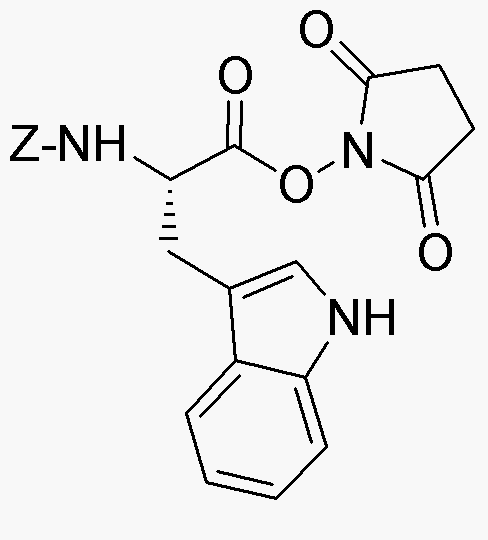Na-Z-L-tryptophan N-hydroxysuccinimide ester is widely utilized in research focused on:
- Peptide Synthesis: This compound serves as an effective building block in the synthesis of peptides, particularly those that require tryptophan residues. Its unique structure allows for selective coupling reactions, enhancing the efficiency of peptide formation.
- Drug Development: In pharmaceutical research, it is employed to create novel drug candidates, especially in the development of therapeutics targeting neurological disorders, due to tryptophan's role in serotonin production.
- Bioconjugation: The ester functionality makes it suitable for bioconjugation applications, allowing researchers to attach biomolecules to surfaces or other molecules, which is crucial in the development of targeted drug delivery systems.
- Fluorescent Probes: It can be modified to create fluorescent probes for imaging studies, aiding researchers in visualizing biological processes in real-time, which is vital for understanding cellular mechanisms.
- Protein Labeling: This compound is also used in the labeling of proteins for various analytical techniques, such as mass spectrometry and chromatography, providing insights into protein interactions and functions.
General Information
Properties
Safety and Regulations
Applications
Na-Z-L-tryptophan N-hydroxysuccinimide ester is widely utilized in research focused on:
- Peptide Synthesis: This compound serves as an effective building block in the synthesis of peptides, particularly those that require tryptophan residues. Its unique structure allows for selective coupling reactions, enhancing the efficiency of peptide formation.
- Drug Development: In pharmaceutical research, it is employed to create novel drug candidates, especially in the development of therapeutics targeting neurological disorders, due to tryptophan's role in serotonin production.
- Bioconjugation: The ester functionality makes it suitable for bioconjugation applications, allowing researchers to attach biomolecules to surfaces or other molecules, which is crucial in the development of targeted drug delivery systems.
- Fluorescent Probes: It can be modified to create fluorescent probes for imaging studies, aiding researchers in visualizing biological processes in real-time, which is vital for understanding cellular mechanisms.
- Protein Labeling: This compound is also used in the labeling of proteins for various analytical techniques, such as mass spectrometry and chromatography, providing insights into protein interactions and functions.
Documents
Safety Data Sheets (SDS)
The SDS provides comprehensive safety information on handling, storage, and disposal of the product.
Product Specification (PS)
The PS provides a comprehensive breakdown of the product’s properties, including chemical composition, physical state, purity, and storage requirements. It also details acceptable quality ranges and the product's intended applications.
Certificates of Analysis (COA)
Search for Certificates of Analysis (COA) by entering the products Lot Number. Lot and Batch Numbers can be found on a product’s label following the words ‘Lot’ or ‘Batch’.
Numéro de catalogue
Numéro de lot/série
Certificates Of Origin (COO)
This COO confirms the country where the product was manufactured, and also details the materials and components used in it and whether it is derived from natural, synthetic, or other specific sources. This certificate may be required for customs, trade, and regulatory compliance.
Numéro de catalogue
Numéro de lot/série
Safety Data Sheets (SDS)
The SDS provides comprehensive safety information on handling, storage, and disposal of the product.
DownloadProduct Specification (PS)
The PS provides a comprehensive breakdown of the product’s properties, including chemical composition, physical state, purity, and storage requirements. It also details acceptable quality ranges and the product's intended applications.
DownloadCertificates of Analysis (COA)
Search for Certificates of Analysis (COA) by entering the products Lot Number. Lot and Batch Numbers can be found on a product’s label following the words ‘Lot’ or ‘Batch’.
Numéro de catalogue
Numéro de lot/série
Certificates Of Origin (COO)
This COO confirms the country where the product was manufactured, and also details the materials and components used in it and whether it is derived from natural, synthetic, or other specific sources. This certificate may be required for customs, trade, and regulatory compliance.


